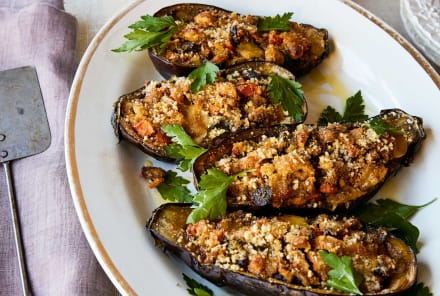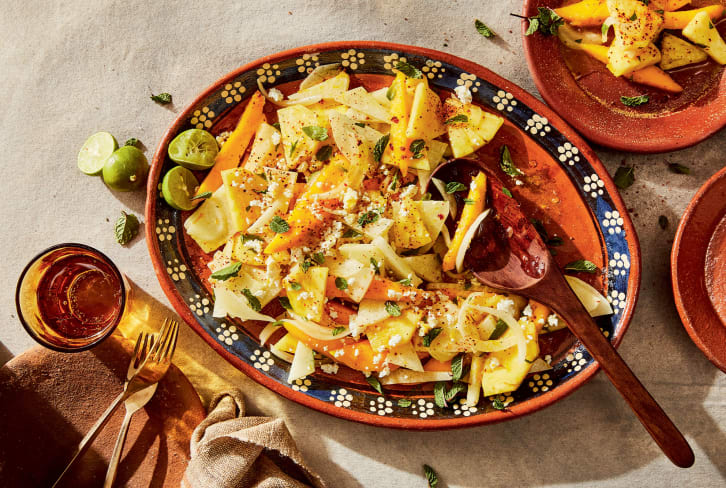Advertisement
11 Ways To Make The Most Of An Anti-Inflammatory Diet + A Food List

If you want to eat for long-term health, lowering inflammation can be majorly beneficial.
Inflammation in the body can cause or contribute to many debilitating, chronic illnesses—including osteoarthritis, rheumatoid arthritis1, heart disease, Alzheimer’s disease, Parkinson’s disease, and even cancer2.
However, research finds that eating an anti-inflammatory diet may help protect against certain diseases3, but could also help slow the aging process by stabilizing blood sugar and increasing metabolism.
That's why, as a doctor and founder of the Kaplan Center for Integrative Medicine, I recommend my patients eat a diet focused on anti-inflammatory principles.
Here, I share some of my top ways to optimize your diet, plus my go-to anti-inflammatory foods.
Anti-inflammatory diet tips.
To make the most of an anti-inflammatory diet, I recommend following these 11 principles:
Consume at least 25 grams of fiber every day.
A fiber-rich diet can help reduce inflammation3 by supplying naturally occurring anti-inflammatory phytonutrients found in fruits, vegetables, and other whole foods.
To get your fill of fiber, seek out whole grains, fruits, and vegetables.
The best sources include whole grains such as barley and oatmeal; vegetables like okra, eggplant, and onions; and a variety of fruits like bananas (3 grams of fiber per banana) and blueberries (3.5 grams of fiber per cup).
Summary
Eat a minimum of nine servings of fruits and vegetables every day.
One “serving” is half a cup of a cooked fruit or vegetable, or one cup of a raw leafy vegetable.
For an extra punch, add anti-inflammatory herbs and spices—such as turmeric and ginger—to your cooked fruits and vegetables to increase the benefits.
Summary
Eat four servings of both alliums and crucifers every week.
Alliums include garlic, scallions, onions, and leek, while crucifers refer to vegetables such as broccoli, cabbage, cauliflower, mustard greens, and Brussels sprouts.
Because of their powerful antioxidant properties, consuming a weekly average of four servings of each can help lower your risk of cancer. If you like the taste, I recommend eating a clove of garlic a day.
Summary
Limit saturated fat to 10 percent of your daily calories.
By keeping saturated fat low (that's about 20 grams per 2,000 calories), you'll help reduce the risk of heart disease.
You should also limit red meat to once per week and marinate it with herbs, spices, and tart, unsweetened fruit juices to reduce the toxic compounds4 formed during cooking.
Summary
Consume foods rich in omega-3 fatty acids.
Research suggests that omega-3 fatty acids reduce inflammation and may help lower risk of chronic diseases such as heart disease, cancer, and arthritis — conditions that often have a high inflammatory process at their root.
Aim to eat lots of foods high in omega-3 fatty acids like flax meal, walnuts, and beans such as navy, kidney and soy. I also recommend taking a good-quality omega-3 supplement.
Summary
Eat fish at least three times a week.
Fish are another fantastic omega-3 rich food. Go for cold-water fish such as salmon, oysters, herring, mackerel, trout, sardines, and anchovies.
Low-fat fish such as sole and flounder, may also have anti-inflammatory benefits.
Summary
Use oils that contain healthy fats.
The body requires fat, but choose the fats that provide you with benefits.
Virgin and extra-virgin olive oil (organic if possible) are the best bets for anti-inflammatory benefits. Other options include high-oleic, expeller-pressed versions of sunflower and safflower oil.
Summary
Eat healthy snacks twice a day.
If you're a snacker, aim for fruit, plain or unsweetened Greek-style yogurt (it contains more protein per serving), celery sticks, carrots, or nuts like pistachios, almonds, and walnuts.
Summary
Avoid processed foods and refined sugars.
This includes any food that contains high-fructose corn syrup5 or is high in sodium6, which contribute to inflammation throughout the body.
Avoid refined sugars whenever possible and artificial sweeteners altogether.
The dangers of excess fructose have been widely cited and include increased insulin resistance7 (which can lead to type-2 diabetes), raised uric acid levels7, raised blood pressure8, increased risk of fatty liver disease8, and more.
Summary
Cut out trans fats.
In 2006, the FDA required food manufacturers to identify trans fats on nutrition labels, and for good reason—studies suggest that people who eat foods high in trans fats9 have higher levels of C-reactive protein, a biomarker for inflammation in the body.
A good rule of thumb is to always read labels and steer clear of products that contain the words “hydrogenated” or “partially hydrogenated oils.”
Vegetable shortenings, select margarines, crackers, and cookies are just a few examples of foods that might contain trans fats.
Summary
Sweeten meals with phytonutrient-rich fruits, and flavor foods with spices.
Most fruits and vegetables are loaded with important phytonutrients.
In order to naturally sweeten your meals, try adding apples, apricots, berries, and even carrots.
And for flavoring savory meals, go for spices that are known for their anti-inflammatory properties, including cloves, cinnamon, turmeric, rosemary, ginger, sage, and thyme.
Summary
Best anti-inflammatory food list.
We just went over a lot of anti-inflammatory diet information. But to get all the go-to foods in one place, here's a comprehensive list to peruse the next time you head to the grocery store:
Vegetables
- okra
- onions
- eggplant
- scallions
- garlic
- leek
- broccoli
- cabbage
- cauliflower
- mustard greens
- Brussels sprouts
- celery
- carrots
Fruits
- bananas
- blueberries
- apples
- apricots
- berries
Whole grains
- barley
- oatmeal
Nuts, seeds, and legumes
- flax
- walnuts
- kidney beans
- soy beans
- navy beans
- pistachios
- almonds
Fish
- salmon
- oysters
- herring
- mackerel
- trout
- sardines
- anchovies
Herbs and spices
- turmeric
- ginger
- cloves
- cinnamon
- rosemary
- sage
- thyme
Foods to avoid on an anti-inflammatory diet.
In addition to including plenty of anti-inflammatory foods in your diet, it's also important to ditch the foods that may be contributing to inflammation in your body. Here's a summary of the foods I recommend avoiding:
- High fructose corn syrup
- High-sodium foods
- Refined sugar
- Artificial sweeteners
- Hydrogenated or partially hydrogenated oils
Incorporating more beneficial anti-inflammatory foods and decreasing not-so-healthy options can be the first step you take for a stronger, healthier body. Here's a sample 7-day meal plan to get you started on an anti-inflammatory diet.
9 Sources
- https://www.ncbi.nlm.nih.gov/labs/pmc/articles/PMC7226834/
- https://www.sciencedirect.com/science/article/abs/pii/S1876162319300690?via%3Dihub
- https://www.ncbi.nlm.nih.gov/labs/pmc/articles/PMC7352291/
- https://www.sciencedirect.com/science/article/pii/S0014299920300297?via%3Dihub
- https://www.ncbi.nlm.nih.gov/labs/pmc/articles/PMC5893377/
- https://www.ncbi.nlm.nih.gov/labs/pmc/articles/PMC7471100/
- https://www.ncbi.nlm.nih.gov/labs/pmc/articles/PMC7774304/
- https://www.ncbi.nlm.nih.gov/labs/pmc/articles/PMC7368167/
- https://www.ncbi.nlm.nih.gov/labs/pmc/articles/PMC7483568/
Watch Next
Enjoy some of our favorite clips from classes
Enjoy some of our favorite clips from classes
What Is Meditation?
Mindfulness/Spirituality | Light Watkins
Box Breathing
Mindfulness/Spirituality | Gwen Dittmar
What Breathwork Can Address
Mindfulness/Spirituality | Gwen Dittmar
The 8 Limbs of Yoga - What is Asana?
Yoga | Caley Alyssa
Two Standing Postures to Open Up Tight Hips
Yoga | Caley Alyssa
How Plants Can Optimize Athletic Performance
Nutrition | Rich Roll
What to Eat Before a Workout
Nutrition | Rich Roll
How Ayurveda Helps Us Navigate Modern Life
Nutrition | Sahara Rose
Messages About Love & Relationships
Love & Relationships | Esther Perel
Love Languages
Love & Relationships | Esther Perel











